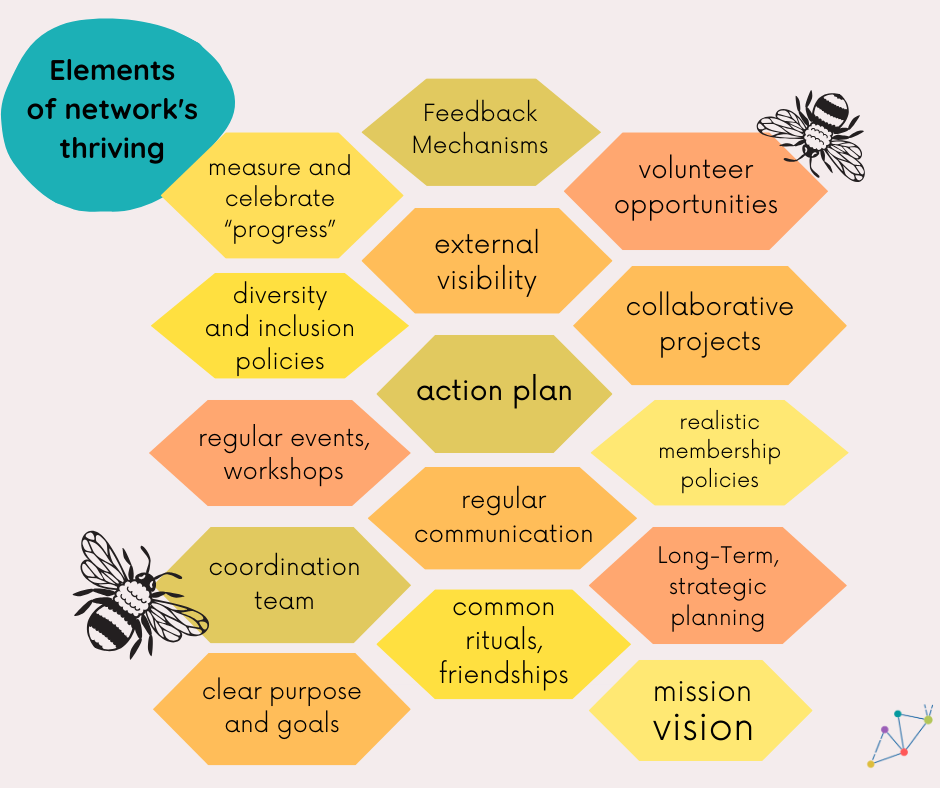THRIVING: Sustaining the connections
Completion requirements

2. Elements of network's thriving
Below we provide a sort of checklist that includes the elements and steps covered in this course which are particularly important for the network to flourish. It is crucial to take into account not only the presence of the specific element but also the “how” of its development within the team and the network.
- Crucial is to have a Clear Mission, vision and Goals. Ensure that all members understand the purpose and goals of the network or organization. This clarity helps in keeping everyone motivated and focused on the same objectives. Written and outspoken arrangements, rules, regulations, and networking practices should resonate with team socio-cultural expectations as well as spiritual belief systems to support their process of seeking and maintaining connections.
- Regular Communication is essential. Use a variety of channels, including emails, newsletters, social media, and in-person meetings, to keep members informed about the organization's activities and updates in the environmental field.
- Create Online Platforms such as a website or a private social network group, where members can connect, share information, and discuss relevant topics. This can also serve as a repository for resources and documents.
- Encourage and facilitate Collaborative Projects Working together on specific initiatives can help build stronger connections among members. These projects should align with the organisation's mission and allow members to apply their skills and knowledge.
- Organize regular Events, Workshops and webinars to bring members together. These events can be educational, networking-focused, or a combination of both. Consider hosting guest speakers and experts to share insights and engage members.
- Provide Volunteer Opportunities: Give members the chance to get involved in hands-on activities, such as clean-up events, tree planting, or advocacy campaigns. Engaging in real-world projects can create a strong sense of purpose and community.
- Implement Feedback Mechanisms to allow members to express their opinions and suggest improvements. A feeling of being heard can strengthen the commitment of members.
- Offer tangible Membership Benefits benefits to members, such as access to exclusive resources, discounts, or recognition for their contributions. This can help retain and engage members.
- Ensure that the organization is applying Diversity and Inclusion and welcomes people from diverse backgrounds. Diversity can lead to a broader perspective and more innovative solutions.
- Establish Mentorship Programs that pair experienced members with newcomers. This can help transfer knowledge, build relationships, and integrate new members into the community.
- Take care of Leadership Development. Provide opportunities for members to take on leadership roles within the organization. This not only shares the responsibility but also empowers individuals to take ownership of the organization's success.
- Measure and Celebrate Progress, track and celebrate achievements. Recognize members' contributions and milestones, whether they are individual or organizational.
- Long-Term Planning: Develop a strategic plan that outlines the organization's vision, mission, and goals for the long term. Having a clear roadmap can keep members committed to the cause.
- Be open to change and adapt to evolving circumstances and challenges. Environmental issues are dynamic, and the organization should be flexible enough to address new concerns.
- Establish Partnerships. Collaborate with other environmental organizations and stakeholders. Partnering with like-minded groups can expand your network and resources.

